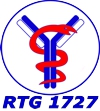MD TP46: α-adrenoceptors in Raynaud’s phenomenon (RP)
Raynaud’s phenomenon (RP) is a cold-induced vasoconstriction that affects mainly the fingers but can occur in other locations such as toes, nose, ears and nipples as well. Raynaud attacks are characterized by a color change of the skin that goes from white to blue and red. Clinically, RP is classified into primary RP, which is idiopathic and secondary RP, which is associated with an underlying disease process. Physiologically, the cold-induced vasoconstriction is mediated by an interaction of noradrenaline with G protein-coupled receptors such as α-adrenoceptors of vascular smooth muscle cells. There are three subtypes of α1-adrenoceptors (α1A,α1B, α1D) and three subtypes of α2-adrenoceptors (α2A, α2B, α2C). Further, there is evidence that α2C-adrenoceptors play a relevant role in the cold-induced vasoconstriction.
The aim of my study is to analyze the expression of leukocytic α-adrenoceptors as well as circulating anti-α1- and anti-α2-adrenoceptor autoantibodies in primary RP. Combined with clinical parameters (nailfold capillaroscopy; interview) I want to find out if it is possible to distinguish primary from secondary RP and to understand underlying mechanisms of primary RP.

- Projects
- Projects
- Associated projects
- MD projects
- Associated MD projects
- Concluded projects
- Concluded TP
- Concluded Ass.TP
- Concluded MD TP
- MD TP1 - Ig Glycolysation
- MD TP2 - Immunoprivilege
- MD TP3 - ANA antibodies
- MD TP4 - Autoantibody prevalence
- MD TP5 - Treatment of EBA
- MD TP6 - Autoantibody-induced tissue injury
- MD TP7 - Neutrophil signalling
- MD TP7b - IgG-IC-induced signalling
- MD TP8 - The role of IL-33 and its receptor ST2
- MD TP9 - Detection of antigen-specific B cells
- MD TP9b - Detection of antigen-specific B cells in BP
- MD TP10 - Old drugs to block T cells
- MD TP10b - Combination of T cell inhibitory compounds
- MD TP10c - T cell inhibitory compounds (in vivo)
- MD TP11 - Identification of "genetic biomarkers"
- MD TP12 - Combinations of B cell modulatory compounds
- MD TP13 - TREM1 in cutaneous inflammation
- MD TP14 - Signaling in PV
- MD TP15 - Autoantibodies in relatives
- MD TP16 - Drug-induced pemphigoid
- MD TP17 - Keratinocyte lipid mediators
- MD TP18 - Neutrophils + IL-17A-Inhibition
- MD TP19 - C5aR-Inhibition
- MD TP20 - IgG-Subclasses
- MD TP21 - NF-kB in EBA
- MD TP22 - Biochip Mosaics in AIBD
- MD TP23 - Diagnostic Techniques on AIBD
- MD TP24 - Anti-stimulatory effects on Neutrophil-signaling
- MD TP25 - Phage library on systemic scleroderma
- MD TP26 - New EBA-scoring sytem
- MD TP27 - Neutrophil signaling-pathway inhibition
- MD TP28 - Inhibition of Keratinocytes
- MD TP29 - Monoclonal antibodies in EBA
- MD TP30 - Enhancing vaccinations under Immunosuppression
- MD TP31 - Non-desmoglein autoantibodies in PV
- MD TP32 - Neutrophil adhesion
- MD TP33 - MicroRNA-21 in BP
- MD TP34 - PI3K-subunits in EBA
- MD TP35 - Signaling cascade inhibition in EBA
- MD TP36 - Signaling cascades in keratinocytes
- MD TP37 - AT1R-antibodies
- MD TP38 - Cell migration regulation
- MD TP39 - mACh-Receptors in systemic sclerosis
- MD TP40 - Hair and EBA
- MD TP41 - CMV-specific T cells
- MD TP42 - Necroptosis in GPA
- MD TP43 - Neutrophils and NETs
- MD TP44 - Mitochondrial genome in AIBD
- MD TP45 - Target antigens in pemphgoid diseases
- MD TP46 - Alpha-adrenoceptors in Raynaud´s phenomenon
- MD TP47 - T cell-receptor-sequences in autoimmune skin diseases
- MD TP48 - Epitope specificity and glycolization
- MD TP49 - Inhibition of keratinocyte-dissociation
- MD TP50 - Transcriptome profile of endothelial cells induced by autoantibodies targeting AT1R/ETAR in systemic sclerosis
- MD TP52 - Expression of B4GALT1 and ST6GAL1 ....
- MD TP54 - Reactivity of serum antibodies ....
- MD TP55 - Identification of potential therapeutics .....
- MD TP56 - Validation of the inhibition of different signalling pathways ...
- MD TP57 - Inhibition of IFN-γ as therapy for epidermolysis bullosa acquisita
- MD TP58 - Characterization of immunoglobulin G subclass distribution ...
- MD TP59 - Development of an experimental pemphigus vulgaris model in adult mice
- MD TP60 - Interactions between GPCR and anti-GPCR IgG autoantibodies...
- MD TP61 - Glycosyltransferases B4GALT1 and ST6GAL1 in...
- MD TP62 - Sensitivity of diagnostic test systems in dermatitis herpetiformis Duhring
- Concluded Ass. MD TP
Principal investigator(s)
Mentors
PhD student

Catharina Frahm





